Jim Shaw - 'Church Elder and Treasurer'
St. Ninian's, Solihull - 45 Years of Service
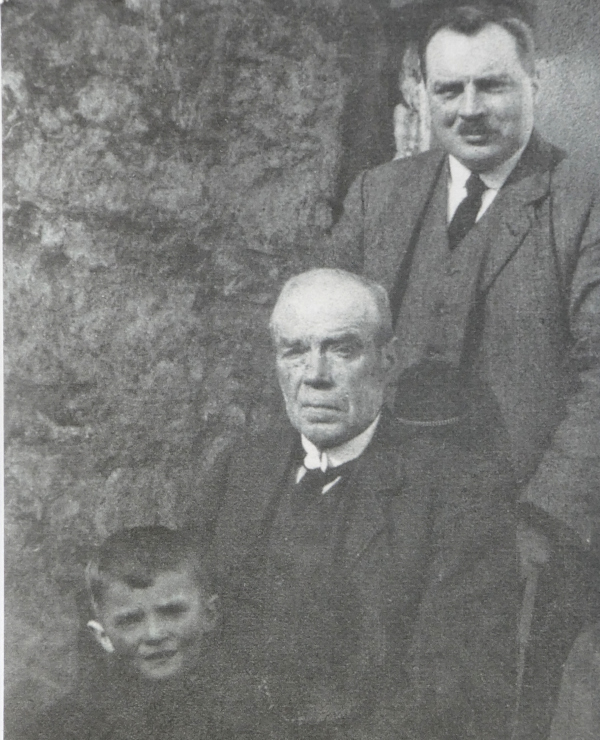
Introduction
A big part of my father's life was his attendance at the church of Saint Ninian's in Solihull. That was the visible part of his Christian faith, the spiritual part he kept to himself, at least to us children.
Protestant tradition
There was a strong Scottish Protestant tradition in the Shaw family going back to at least my great-great grandfather, Joseph.
His son, James, my great grandfather, had been an elder of the church in Glenboig and, aged 65, was presented with a gold watch and spectacles in recognition of his service to the church.
"PRESENTATION.-The Rev. McGavin Boyd presided over a large turnout of the members of the Glenboig
Established Church, who met in a social capacity the other evening, when Mr James Shaw, late
farmer Raemoan (sic), who has been connected with the Mission as an elder since its
organisation, was
presented with a valuable gold watch and a pair of gold spectacles in recognition of his long
and faithful services to the church. Mr Shaw is well known in the Cumbernauld district, being a
son of the late Joseph Shaw, farmer, Carrickston."
- Kirkintilloch Gazette 19 July 1912
In turn his son, also James, my grandfather, had been an elder and lay preacher at West St. Giles in Edinburgh for five years until his untimely death
"A week ago, in the early hours of the morning, Mr. James Shaw, of 23 Marchmont Crescent, was taken suddenly and unexpectedly ill, and despite urgent medical attention passed away thereafter. His tragic death was a profound shock to every member, and brought to each a very real sense of personal loss.
Ordained to the eldership in 1944, he very quickly made for himself a place in the esteem and respect and affection of his fellow-elders, who very soon came to recognise his sterling worth, his genial friendliness, his willing and untiring service, and the conscientious and sincere devotion to duty. In the district in which for these past five years he served faithfully as elder there was no visitor more welcome, for he gave to every household his interest and his friendship.
The passing of his wife 18 months ago was a heavy blow which
took toll of his strength, though in the happiness of his home he found compensation, and in the
reality of his Christian faith comfort and strength. As a congregation we mourn the passing of
an upright life, of a real friend, and of a devoted elder and we would commend to the sure
mercies of a faithful God his son and daughters in their sore loss"
- West St. Giles Supplement December 1949
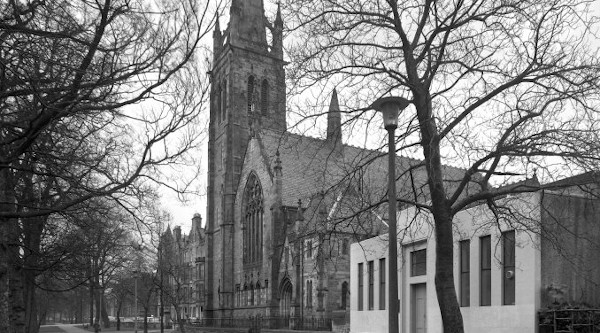
Foundations
Along with his family my father had attended West St. Giles Church, Edinburgh, passing through their Sunday School and being awarded several prizes.
The 1939 Christmas Message from King George VI contained a verse from a poem that made a strong impression that stayed with my father, then aged 19, for the rest of his life, putting in words the basis of his Christian faith.
And I said to the man who stood at the gate of the year:
“Give me a light that I may tread safely into the unknown.”
And he replied:
“Go out into the darkness and put your hand into the Hand of God.
That shall be to you better than light and safer than a known way"
"God Knows" - Minnie Louise Haskins
A Diversion
During the early part of WW2 my father served with the RAF in Canada where he was befriended by the Sharp family, first generation immigrants from Scotland, for whom an open expression of their faith was very important, articularly for their evangelical daughter, Daisy. No doubt my father's shared faith and nation of birth helped endear him to them.
Daisy wrote many letters to my father urging him to be 'born again' to the faith. It isn't known how my father felt about this though he was minded to emmigrate to Canada post-war if circumstances had allowed.
Marriage
Prior to D-Day my father was posted to England, eventually to provide engineering support to 140 Squadron RAF immediately before D-Day and follow it into France, Belgium and the Netherlands as the invasion progressed. With the disbandment of the squadron my father was posted back to England where he was to meet the woman who became my mother.
Having been born in England she had been brought up in the Church of England tradition with a strong Christian faith but, not, she always said, as strong as my father's
They married in West St. Giles Church, Edinburgh, my father's home church.
Birmingham
A job offer from the Rover Co. Ltd. of Solihull in 1950 meant the family moving to Birmingham. My mother naturally joined the local parish church with its worship driven by the Book of Common Prayer, its bishops and responses to the set words of the priest.
This was a step too far for my father. The Presbyterian Church of England was the spiritual home for many an exiled Scot in England and their nascent church, a 'preaching station', in Solihull, meeting in rented rooms in the Solihull Manor House, on the High Street met his needs.
As children being brought up in the 1950s the Church of England tradition was the de facto norm for those attending the local authority primary schools so naturally we made visits to the parish church, attended its Christmas parties and Summer fêtes. Our mum attempted to get us to attend services too but it wasn't for us, what with its cold, dark nave and kneeling in the pews, so it became our father's responsibility to take us to church.
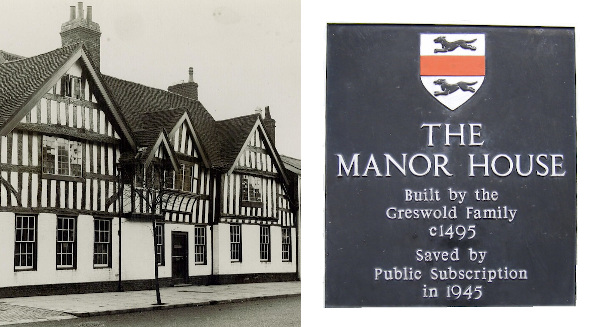
The Manor House
In the early days that meant being reluctantly hustled to catch the Midland Red 175 bus from just beyond The Wheatsheaf in Sheldon to the end of the High Street, Solihull. (In general Midland Red bus stops were only found beyond the city boundary).
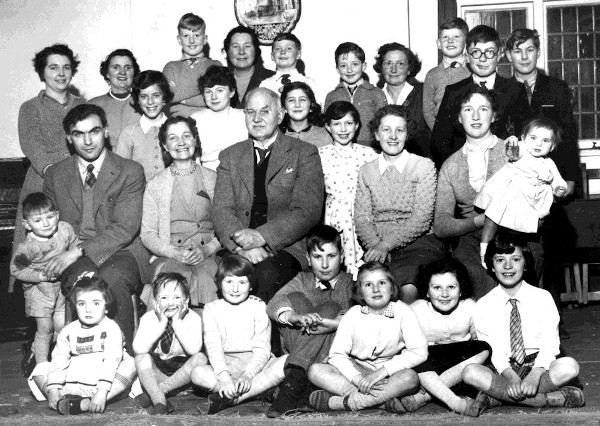
The Manor House had a strong smell and everything creaked! We had to climb the stairs to the main room at the back of the first storey. At the far end would stand Mr. Ferrie, a large, tall man, who lead the service. Part way through we would be lead to one of two rooms at the front of the Manor House to attend the Sunday school, at first taken by Mrs Stevenson, a Scottish grand-motherly type of lady, wife of John Stevenson, an architect and the Sunday school superintendent. Later David Brown and sometimes his wife, Jean, would take classes. They were a couple with a young family. I always felt that the Browns always paused before taking an action as if asking themselves what was the Christian thing to do. My sole memory of lessons was in placing matchboxes, modelling books of the Bible, in order into a small bookcase made from hardboard, a lesson long forgotten, if ever learnt!
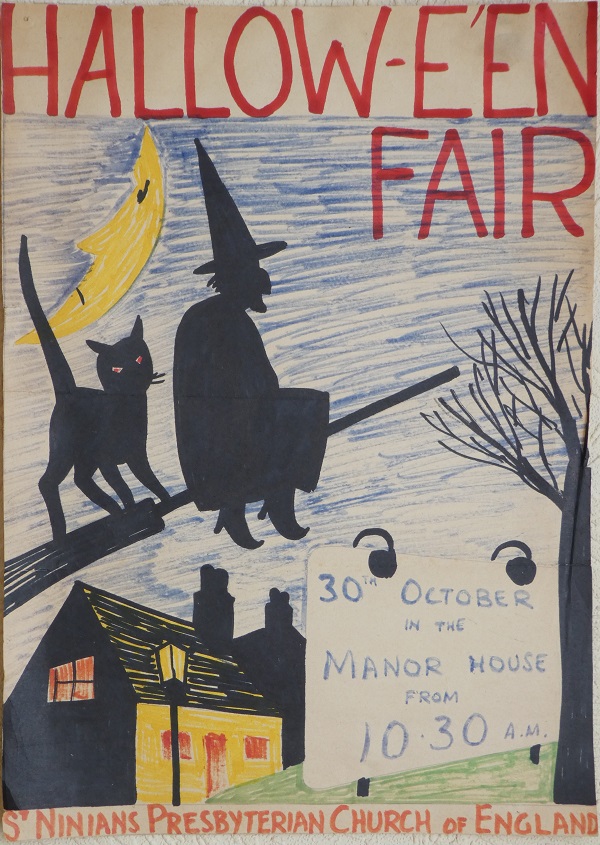
Treasurer
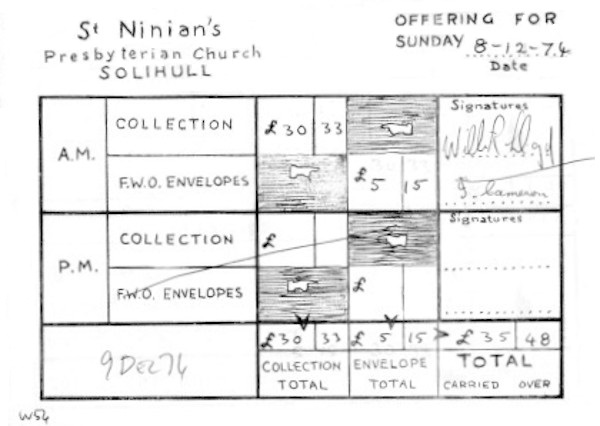
In 1956, the 'preaching station', having being recognised by the Presbyterian Church of England, they appointed a minister, Rev. Cyril C.E. Mercer in charge. That same year my father took on the role of treasurer, a task that he was to carry out for 40 years. Fund raising was especially important for the Solihull congregation as they planned to build a new church building in Caldwell Grove, Solihull, next to Lode Lane. John Stevenson was the architect.
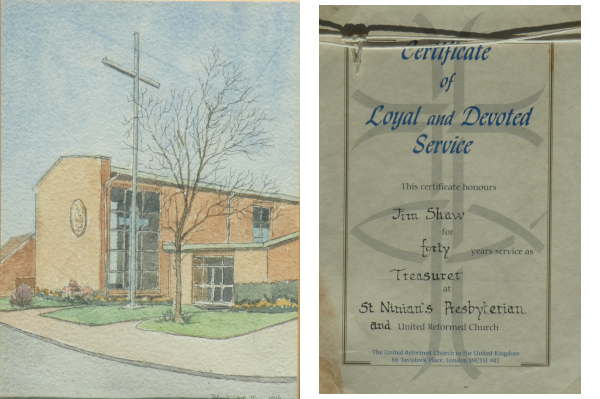
At a service held 19 January 1958 five elders, including my father, were appointed. A year later, in March 1959, the foundation stone for St. Ninian's was laid and in April 1961 it was dedicated to the worship of God. Rev. C.C.E Mercer continued to lead until July 1962 when the Rev. John Forsyth took up the challenge.
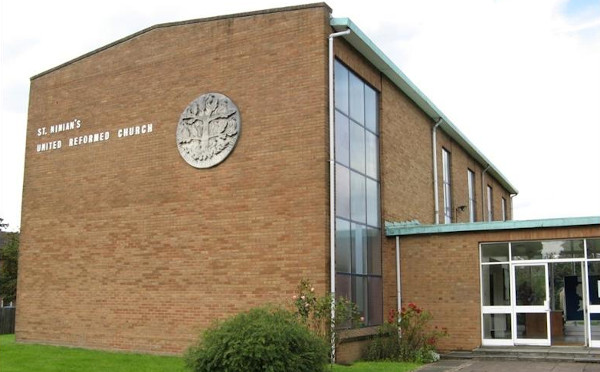
A New Building
The new building was a big change from the Manor House, large and airy with a car park alongside. An entrance vestibule was connected to the main hall by a short corridor, with toilets leading off, and opposite the cloakroom at the other side. Standing in the doorway to the main hall to the left was a raised area housing the Communion Table in the centre with a round vertical wooden panelled pulpit on the left, part wrapped around by an open spiral staircase. Behind the pulpit was the electronic organ, its loudspeakers mounted above the main door. The raised area could be partitioned off from the main hall by heavy curtains drawn in from each side.
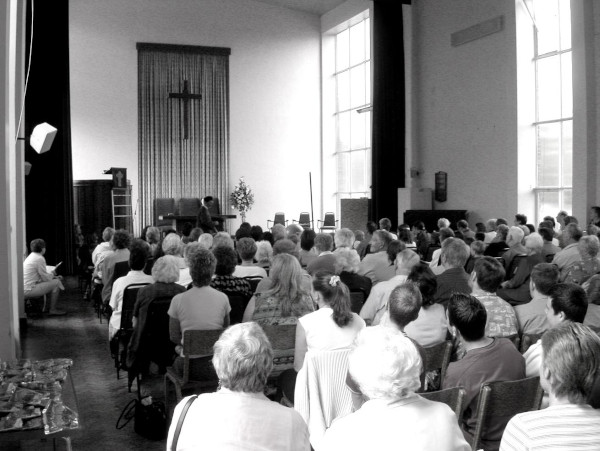
The hall itself was rather plain, high ceilinged and well-lit by tall, reeded windows on each side. The rear wall was covered in acoustic tiling and had double-doors leading to the room used by the Sunday school and a single door leading to the minister's room. Beyond that, and accessible to both rooms was a corridor leading to another meeting room, a kitchen, utility room and toilets, with a back door next to the minister's room.
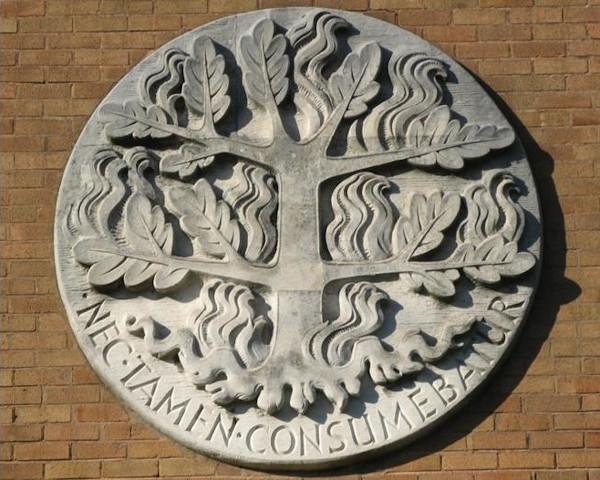
A New Symbol
Before the move to the new building newsletters and other publications bore a representation of 'the burning bush' and the motto 'Nec Tamen Consumebatur', (However, it was not consumed), as did a cloth hanging over the lectern at the Manor House. This emblem was engraved in situ on the exterior front wall of the new building and incorporated in the freeze on the front of the Communion Table.
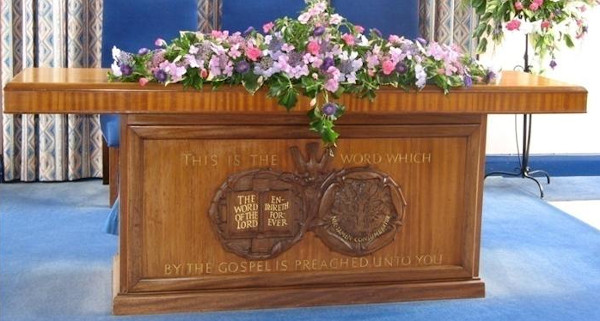
The tall, free-standing cross by the side of the church made a distinctive landmark so it wasn't long before it was thought that graphics based on views of St. Ninian's and its cross made a more specific and readily identifiable connection than the generic 'burning bush. Various designs were to be used over the years on time it was thought to be more meaningful to use a sketched representation of the church on the the front covers of newsletters, directories and reports, many the work of my father.
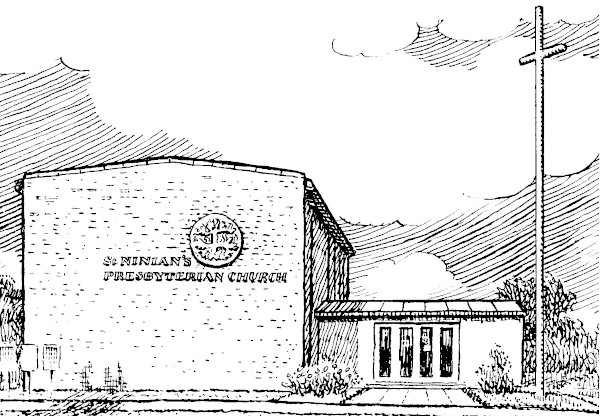
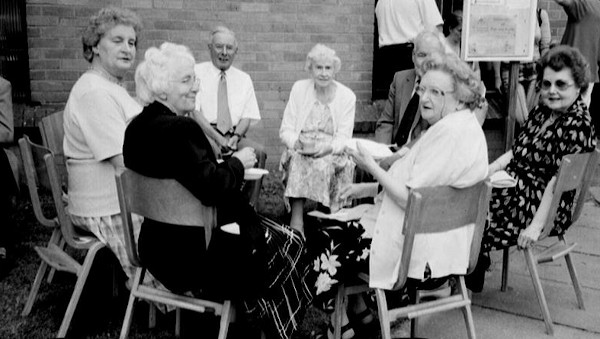
Handyman
The new church needed new chairs, stacking bent wood and plywood ones with a small shelf at the rear, intended to take a hymn book. Dad constructed a jig that fitted neatly over the shelf. The barrel of a mortice key was set into the jig as a guide for drilling a pilot hole through the shelf. This was then opened out using a hand brace and bit to make a hole to accept a the small shot glasses used for taking communion.
These chairs gave sterling service for most of the years that St. Ninian's was open. Some that were abused suffered from split seats and my father took them home to repair. (I am not that sure that any were repaired, perhaps because of the risk of taking on personal liability if the repair was to fail?). I believe that a batch of second-hand chairs was bought to replace most, if not all, of the original chairs.
Typically any small repair or maintenance work needed in the church would be carried out by my father as a matter of course. He would be the one that would reset the time clocks controlling the church heating, perhaps making a special visit to advnce the setting if an exceptional cold spell was forecast. He was forever seeking ways to ensure that the running expenses of the church were kept under control.
The church hall had always been intended to be multi-use, at first by groups affiliated to the church, like the Brownie pack or the Badminton Club or Church Sales and Fêtes. Later on other religious groups conducted their own services there, some having a tradition of amplifying the voice of the preacher. Here again my father stepped in and made storage cupboards for their equipment and fitted the permanent wiring that they required.
Attendance of the Children
By the time St. Ninian's was open we children had been well-used to being taken to church by car, not that it improved our timekeeping. A system of pocket money had been established by which we received one penny per year of our age per week. To encourage the idea of giving to the church this was raised to two pennies, i.e. 5p at age six. We tended to 'forget' to bring money with us so Dad had to pass out extra pennies when the collection plate came around. We never knew how much money Dad placed in the plate as, quite possibly, as treasurer he had instigated a 'Free Will Offering' scheme. Each scheme member was given a set of numbered and dated envelopes into which they placed their pledged offering. If need be the collection assistants could check the contents of each envelope against the anonymised register. The contribution was to be a secret between the contributor and God, a personal obligation devoid of pride or shame within the congregation.
It must have been a great disappointment to our father but as time went on and the expected move from Sunday School to full church membership got nearer I for one felt no call to the faith and I stopped going. I don't think it was long before my sister and brother saw no reason to go either if I wasn't going. Whatever my father thought I don't recall him making any fuss over my decision, I didn't believe and that was that.
My father continued to attend every service that he could and taking his place at Session meetings. Goodness how many hours he put in as treasurer. In the early years hand printing forms that he had designed and in later years laying up masters for use by a commercial printer. He designed posters and magazine covers as well as producing financial reports and literature to encourage more and consistent giving. He took on some of the role of caretaker, making sure that small repairs were done and that heating costs were kept under control by setting time switches and thermostats.
United Reformed Church
In 1972 the Presbyterian Church of England joined with the majority of the Congregational Churches of England and Wales to form the United Reformed Church, potentially threatening the existence of St. Ninians as there was another church of the new denomination less than two miles away, St. Mary's at Hobbs Moat. What had been empty ground to the south of St. Ninian's was taken up as the Solihull Bypass, opened in 1975. While the church now became more visible to more passers by it was no longer obvious how to get to it, vistors from the Solihull direction now having to drive further towards Sheldon and approach from Moat Lane.
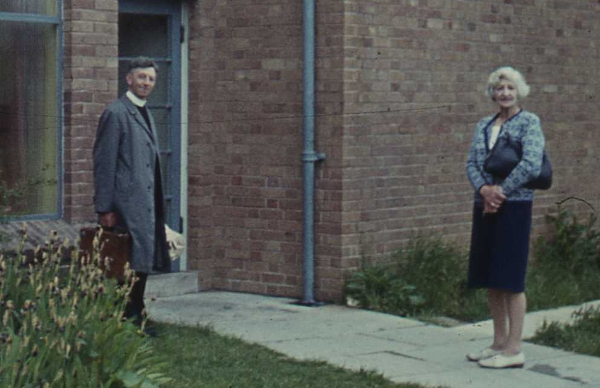
Rev. John Forsyth retired in 1982. By then we children has stopped attending services so I never knew his replacement, Rev. Kenneth Fear, who served for eight years. Before his arrival it had been decided to purchase a new manse at 118 Buryfield Road, heavily involving my father as treasurer, not least with helping out with making the house fit to be used by the minister. At the end of his term it proved difficult for the church to take back possession of the manse, again placing a heavy burden on my father.
A New Organ and Amplified Speech
A new organ was purchased in 1986, following a lot of effort by my father in fund raising. In part this was a requirement of other users of the hall who found the old organ unreliable and who also believed in using amplified speech during their worship. My father, using his electrical skills, helped in the routing of cables and the selection of a suitable amplifier.
In the period 1990-1998 Reverends Geoffrey Tate, Paul Breeze, Christine Craven and Gillian Jones served for short spells, in many cases taking time out from their own churches. I believe that during this time various elders had to step in to lead the congregation. This included my father, so he joined his father and grandfather as taking on the role of lay preacher.
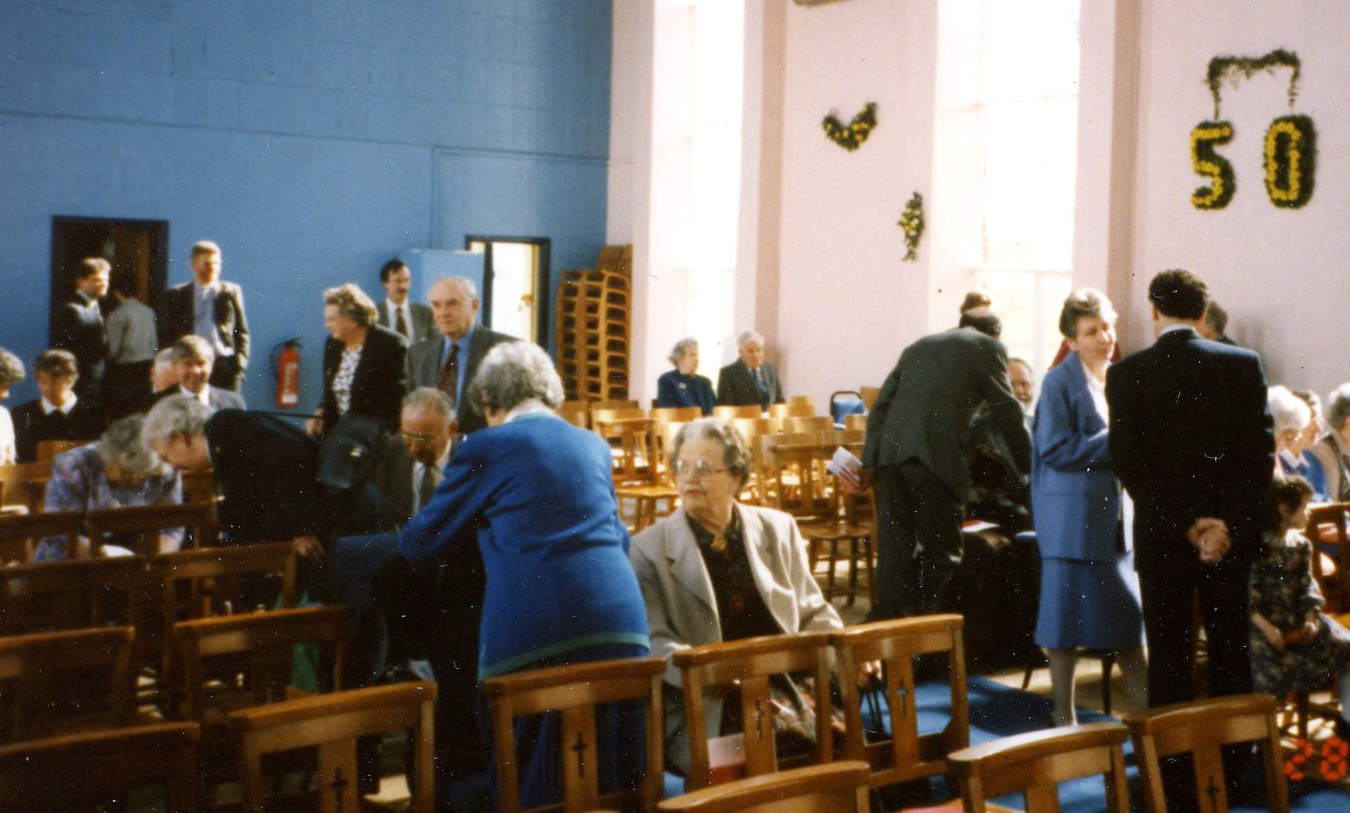
A permanent minister was needed and the Rev. Mary Burgess was short-listed and strongly supported by my father as one of the longest serving elders. She would become the last full-time minister at St. Ninian's.
Faithful Supporter
In addition to his attendance of church services and the various committee meetings My father always supported events such as the various church fêtes. Particularly around Christmas he would make marzipan fruits for sale to boost church funds. (Although realistic in appearance they always disappointed me as they didn't taste of the fruit they modelled, just as well as one of his specialities was a 'raw' potato, a 'fruit' probably unique to my dad).
At home Christmas Day events couldn't really start until Dad returned from church, we worked to his schedule. (In later years this became equally true of ordinary Sundays too, as Dad took time out to have a cup of tea and a chat with the various widows that he had either given a lift to or who were on his route home, much to the frustration of my mum who saw her meal plans fall apart)
Without doubt St. Ninian's had great significance in the life of my father, fulfilling a spiritual and social need in his life
Presentation
The Lord is my pace setter1 - I shall not rush.
He makes me stop for quiet intervals,
He provides me with images of stillness
which restores my serenity.
He leads me in ways of efficiency
through calmness of mind,
And his guidance is peace.
- Tokio Megashie
In January 2003 my father completed 45 years service as an elder of the church and at the AGM held 18 March 2003 he was presented with a framed modern version of the 23rd Psalm. Sadly this was to be his last meeting as he fell ill and was taken into hospital on 23 March 2003 only to die on 3 April 2003, the end of the financial year, appropriate for an ex-treasurer. Naturally his funeral service took place at St. Ninian's and his ashes scattered under a tree at the front along with some miniature daffodils.
Jim Shaw remains with us as an Elder at St Ninian's and we realised that in January of this year he had been fulfilling this role for 45 years!! At the AGM on Tuesday 18th March we gave him a framed script of a modern version of the 23rd Psalm and a card expressing our thanks for his long service, his commitment, his faithfulness to his Lord seen in such hard work, support and concern. Thank you so much Jim - May God continue to bless and sustain you with his loving presence.
Postscript
Rev.Mary Burgess conducted her final service on 29 July 2007 and St. Ninian's held its final event in December 2007, the congregation dispersing to St. Mary's, Hobbs Moat or Knowle URC
In late 2009 St. Ninian's building and land was sold to the Coptic Orthodox Church. By the Summer of 2011, the Coptic Church started its services on a regular basis serving the congregation every week using the existing building.
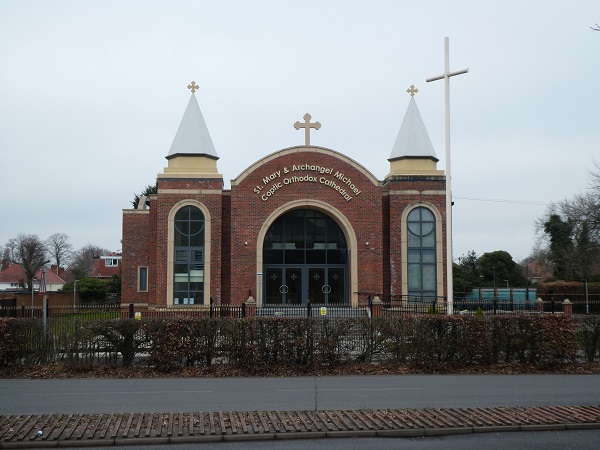
With the plan for a new building approved, funding in place and building contracts signed the demolition of the old and construction of the new building started in September 2016. All that remains of St. Ninian's is the tall, white steel cross.
The plans showed that the trees fronting St. Ninians were to remain and indeed would be protected behind the fence surrounding the site. Initially this proved to be the case, the building went up, the fence was erected and the trees were still there. But once the cathedral was opened the trees were cut down, perhaps they were diseased and considered to be unsafe?
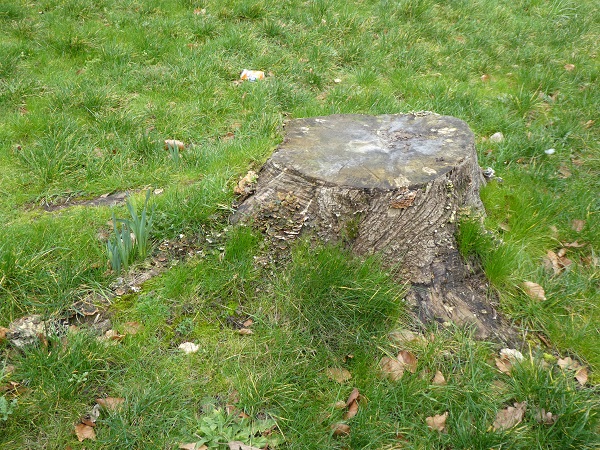
Fortunately the stump of the tree where my father's ashes were scattered remains and the miniature daffodils planted there continue to grow.
He maketh me to lie down in green pastures: he leadeth me beside the still waters.
He restoreth my soul: he leadeth me in the paths of righteousness for his name's sake.
- 'King James' Bible